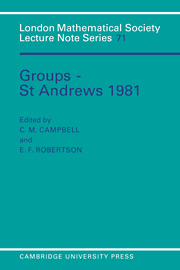Book contents
- Frontmatter
- Contents
- Preface
- Twenty-five years of Groups St Andrews Conferences
- Original Introduction
- 1 An elementary introduction to coset table methods in computational group theory
- 2 Applications of cohomology to the theory of groups
- 3 Groups with exponent four
- 4 The Schur multiplier: an elementary approach
- 5 A procedure for obtaining simplified defining relations for a subgroup
- 6 GLn and the automorphism groups of free metabelian groups and polynomial rings
- 7 Isoclinisms of group extensions and the Schur multiplicator
- 8 The maximal subgroups of the Chevalley group G2(4)
- 9 Generators and relations for the cohomology ring of Janko's first group in the first twenty one dimensions
- 10 The Burnside group of exponent 5 with two generators
- 11 The orientability of subgroups of plane groups
- 12 On groups with unbounded non-archimedean elements
- 13 An algorithm for the second derived factor group
- 14 Finiteness conditions and the word problem
- 15 Growth sequences relative to subgroups
- 16 On the centres of mapping class groups of surfaces
- 17 A glance at the early history of group rings
- 18 Units of group rings: a short survey
- 19 Subgroups of small cancellation groups: a survey
- 20 On the hopficity and related properties of some two-generator groups
- 21 The isomorphism problem and units in group rings of finite groups
- 22 On one-relator groups that are free products of two free groups with cyclic amalgamation
- 23 The algebraic structure of ℵ0-categorical groups
- 24 Abstracts
- 25 Addendum to: “An elementary introduction to coset table methods in computational group theory”
- 26 Addendum to: “Applications of cohomology to the theory of groups”
- 27 Addendum to: “Groups with exponent four”
- 28 Addendum to: “The Schur multiplier: an elementary approach”
26 - Addendum to: “Applications of cohomology to the theory of groups”
Published online by Cambridge University Press: 07 September 2010
- Frontmatter
- Contents
- Preface
- Twenty-five years of Groups St Andrews Conferences
- Original Introduction
- 1 An elementary introduction to coset table methods in computational group theory
- 2 Applications of cohomology to the theory of groups
- 3 Groups with exponent four
- 4 The Schur multiplier: an elementary approach
- 5 A procedure for obtaining simplified defining relations for a subgroup
- 6 GLn and the automorphism groups of free metabelian groups and polynomial rings
- 7 Isoclinisms of group extensions and the Schur multiplicator
- 8 The maximal subgroups of the Chevalley group G2(4)
- 9 Generators and relations for the cohomology ring of Janko's first group in the first twenty one dimensions
- 10 The Burnside group of exponent 5 with two generators
- 11 The orientability of subgroups of plane groups
- 12 On groups with unbounded non-archimedean elements
- 13 An algorithm for the second derived factor group
- 14 Finiteness conditions and the word problem
- 15 Growth sequences relative to subgroups
- 16 On the centres of mapping class groups of surfaces
- 17 A glance at the early history of group rings
- 18 Units of group rings: a short survey
- 19 Subgroups of small cancellation groups: a survey
- 20 On the hopficity and related properties of some two-generator groups
- 21 The isomorphism problem and units in group rings of finite groups
- 22 On one-relator groups that are free products of two free groups with cyclic amalgamation
- 23 The algebraic structure of ℵ0-categorical groups
- 24 Abstracts
- 25 Addendum to: “An elementary introduction to coset table methods in computational group theory”
- 26 Addendum to: “Applications of cohomology to the theory of groups”
- 27 Addendum to: “Groups with exponent four”
- 28 Addendum to: “The Schur multiplier: an elementary approach”
Summary
In 1981 the importance of homological algebra as a tool in group theory was beginning to be recognised. After the pioneering work in the 1940's by S. Eilenberg, S. MacLane and B. Eckmann on the homology and cohomology of groups, twenty years elapsed before really convincing applications appeared: the prime example was Gaschütz's famous theorem on the existence of outer automorphisms of finite p-groups. The well known sets of notes by K. W. Gruenberg and U. Stammbach, which were published in the 1970's, had proved to be a stimulus to research, and already a body of work had appeared in the literature. It seemed timely to write a survey for Groups St Andrews 1981.
The twenty five years which have elapsed since that critical conference have witnessed a continuation of the trend in group theory to introduce techniques from homological algebra, as well as other areas of mathematics. Today many group theorists are conversant with a variety of homological methods, including spectral sequences. Our aim here is to survey some of the achievements during this period.
Until about 1980 group theoretic interpretations of the cohomology groups Hn(G,M) had only been found only for n ≤ 3; these arise of course from the classical theory of group extensions. The problem of finding group theoretic interpretations of Hn(G,M) for arbitrary n was solved by D. F. Holt and J. Huebschmann.
- Type
- Chapter
- Information
- Groups - St Andrews 1981 , pp. 365 - 367Publisher: Cambridge University PressPrint publication year: 1982



